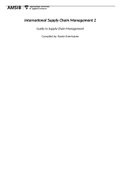Summary
Summary of International Supply Chain Management 2
- Course
- Institution
This summary for the course International Supply Chain Management 2 provides readers with all the key aspects of chapters 2,7,9, and 11 from the material "Guide to Supply Chain Management". In addition, chapters 5,6, and 7 from the material "Export Management: A European perspective" is broken do...
[Show more]



